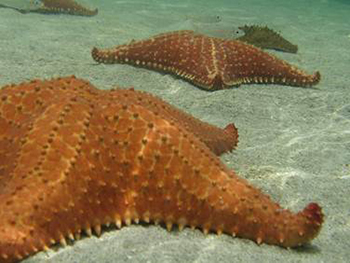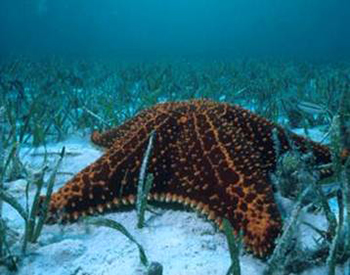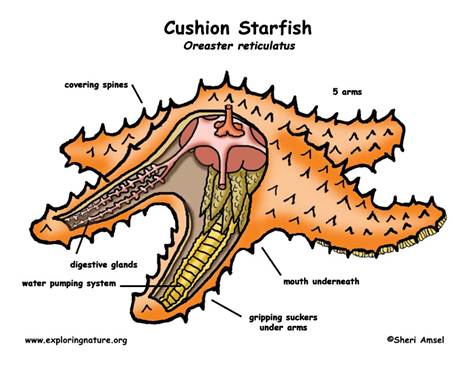Cushion Star


Taxonomy
Kingdom: Animalia
Phylum: Echinodermata
Class: Asteroidea
Order: Valvatida
Family: Oreasteridae
Genus: Oreaster
Species: O. reticulates
Common name: Cushioned Star
Other Names
Red Cushion Sea Star
Tropical Sea Star
Cushion Sea Star
Pin-Cushion Sea Star
Morphology
The cushion star is an invertebrate, therefore possess no spinal column. Like most Echinoderms, the cushion star has a five point radial symmetry. Cushion stars may have four, five, or six arms. Unlike the brittle star, there is no defined body. Tube feet located under the arms possess small suckers. These tube feet are connected to a water vascular system that is used for movement, nutrient distribution, waste management, and respiration. Skin color may come in several different colors in order to camouflage itself from predators in the sea. The color of adult cushioned stars can be brown, orange, red, or yellow. The juveniles are mottled green in color that affords them camouflage in their sea grass bed refuge (Scheibling 1980a). A characteristic plating of calcium carbonate is found in the skin of cushion stars and knobby spines on top. This gives the organism more protection in its environment. Robust body and arms along with its bumpy appearance gives the impression of a pin cushion. Individuals of this species can grow up to 50 cm in diameter.

Habitat
The cushioned star occurs in the eastern and western Atlantic, from North Carolina to Brazil and Cape Verde Islands in western Africa. Adult Oreaster reticulatus are usually found in calm shallow waters (depths from 1 - 37 m) and more commonly occur on calcareous sandy bottoms (Anderson 1978, Guzman and Guevara 2002). Larvae and juveniles are usually found in sea grass beds (Guzman and Guevara 2002). This species prefers a more course, calcareous sandy bottom that is surrounded by tall grass. In Belize, Mangrove and fringing reefs, like dense sea grass beds, may provide a protective environment for recruits that undergo an ontogenic shift to adult habitats, such as sand flats, as they mature reproductively (Scheibling and Metaxas 2010). Throughout the Caribbean (and the tropics worldwide) these habitats are threatened by shoreline alteration, pollution, destructive and unsustainable fishing practices, and, for coral reefs especially, the impacts of ocean warming and acidification
Reproduction
Oreaster reticulatus have separate sexes and reproduce annually in summer in subtropical regions. In more tropical areas where water temperatures are high nine months out of the year, there is asynchronous spawning year round (Guzman and Guevara 2002). The planktonic larvae will be completely developed but will lose their buoyancy, settle and metamorphose in sea grass beds within 23 days at 23 degrees C.
Feeding
Cushion stars have a wide variety of nutrient sources. It is an omnivore, feeding on epiphytic microorganisms, echinoids, holothuroid juveniles and invertebrates (Wulff 1995, Guzman and Guevara 2002). Oreaster reticulatus gathers large piles of sand up with its arms then everts its large cardiac stomach, digesting the material outside of its body. O. reticulatus can turn over sediment 1.9 times within 24 hours (Scheibling 1980b).
Ecological Importance
There is currently no major ecological importance of Oreaster reticulatus.
Summary of recent research
In 2008 Miami University conducted studies to see if Cushion Sea Stars have a preferable living environment. They are more densely populated in one area of the seabed than others. Researchers used a method called randomized area sampling of a specific population. Several studies have been conducted over Oreaster reticulatus’ feeding behavior and how it affects the marine environment. One study proved this species consumed a harmful amount of sponges that did not recolonize for another 15 years (J. P. Grassle, New Brunswick).
Personal Interest
I chose to study the cushion star because of its unique structure and mutable connective tissue. The Oreaster reticulatus species will be spotted in Belize waters therefore a sensible choice. My curiosity of how and why the organism holds itself up in such a way also strikes an interest. Picking the cushion star would allow me to further my knowledge on a species that I will see during my trip in Belize and inform me on the structure of the organism. The mutable dermis and connective tissues is an astonishing topic that has been severally researched for possible human benefit and definite knowledge. Regeneration of a body part is a remarkable phenomenon that these Echinoderms possess.
Citations
Scheibling RE. 1980a. Abundance, spatial distribution, and size structure of populations of Oreaster reticulatus (Echinodermata: Asteroidea) on sand bottoms. Marine Biology 57:107-119.
Scheibling RE. 1980b. Dynamics and feeding activity of high-density aggregations of Oreaster reticulatus (Echinodermata: Asteroidea) in a sand patch habitat. Marine Ecology Progress Series 2:321-327.
Guzman HM and CA Guevara. 2002. Annual reproductive cycle, spatial distribution, abundance, and size structure of Oreaster reticulatus (Echinodermata: Asteroidea) in Bocas del Toro, Panama. Marine Biology 141:1077-1084.
Scheibling, R. E., & Metaxas A. (2010). MANGROVES AND FRINGING REEFS AS NURSERY HABITATS FOR THE ENDANGERED CARIBBEAN SEA STAR OREASTER RETICULATUS. Bulletin of Marine Science. 86, 133-148.
Photo by Elizabeth Lacey. 26.08.09.
J. P. Grassle, New Brunswick. Marine Biology. 1995.